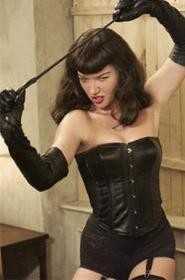At the same time, the kinkier the scenario -- be it girl-girl slap-and-tickle or a little night music for gag and rope harness -- the more she looked like a giggly teen at a pajama party. By the 1980s, when Page reemerged as a pulp icon, her combination of severe bangs, growled come-hithers, and strapping poses served as camp, nostalgia, an emblem of post-feminist subversion, and a fantasy figure for tops as well as bottoms. In her photos and one-reelers, she has the ingredient perhaps most crucial for obsession: an image capable of reflecting anything a viewer projects onto it.
That surface is where The Notorious Bettie Page dwells. Neither a mock-heroic cockeyed-success story like Ed Wood nor a Walk the Line-style exercise in hagiography, Mary Harron's facile but hugely entertaining black-and-white biopic seems most interested in its subject -- a studious southern girl who became the world's most celebrated fetish pinup -- as an object. A zippy, startlingly sweet elegy for the relative innocence of postwar smut, it's also a tricky consideration of a viewer's transformative gaze -- whether that viewer is a lonely bondage hound, a photographer looking to make a fast buck, or even a director aiming a camera at her unclothed star.
After an amusing waterfront-noir opening, a police sting staged as equal parts Reefer Madness and Sweet Smell of Success, the screenplay by Harron and her American Psycho collaborator, Guinevere Turner, begins in fairly conventional lives-of-the-famous terms. Framed by Senator Estes Kefauver's porn inquests in 1955, to which Page was summoned (she never testified), the movie briskly sketches her religious roots and unhappy adolescence in Nashville, a bad early marriage, and a horrific encounter with some backwoods predators.
To Harron's credit, these incidents don't come across as explanations or cheap psychology; there's no aha! moment that draws a line connecting Page's lousy experiences with men -- or her religious background -- to her career. Instead, the movie's Bettie, played with sunny forthrightness by Gretchen Mol, passes from one eager shutterbug to another as a game if somewhat bemused subject, allowing the context to be set around her. The breeziest sections of the film involve her "notorious" bondage shoots with photographer Irving Klaw (Chris Bauer) and his mother-hen sister, Paula (Lili Taylor), who provide taboo specialty material to discerning patrons. If Bettie and other impoverished girls can pay the rent by playing dress-up, paddling each other in pantomime before collapsing in a fit of laughter, who's getting hurt?
Nobody, the movie argues: not the customers, whose deviant tastes look quaint compared to the Caligulan excesses of the internet, nor the women, who take the sting out of the violent fantasy scenarios by participating joyfully. Harron and cinematographer Mott Hupfel break the monochromatic visual scheme for blazing color recreations of 1950s men's-mag covers, as if the liberation they offered from the imposed moral standards of the time radiated like sunlight.
Ironically, in the role of a woman who survives in the public eye as a fascinating question mark, Mol makes a bigger impression than she ever has onscreen before. She plays Page not as a sex bomb, but as a wholesome down-home kid, who saw no reason to believe she was doing something wrong by undressing or posing with a whip. In one of the movie's best scenes, Bettie strips nude for an acting student in a park, and something about the casual, unguarded way Mol slips out of her clothes and basks in the light removes any hint of prurience from the moment. She disarms the camera.
The story doesn't have a very happy ending. Page's modeling career in New York lasted only seven years; there are stories that her later years involved religious obsession, one violent incident, and a subsequent stay in a mental institution. Harron stops the movie before it enters this phase: Her Bettie acknowledges her past, admits no shame, then keeps the rest to herself. The writer-director gives the audience no reason to think they've seen the real Bettie Page -- just a lot of dazzling surfaces.
That seems fair, even if it renders The Notorious Bettie Page somewhat unsatisfying. A recent L.A. Times profile described Page, now 82, as finally enjoying the fruits of her career. She signed autographs and spoke willingly, but there was one thing she would not provide: her current photograph. Fifty years after the fact, the real Bettie Page has held onto the one thing collectors, biographers, and even this diverting biopic have desired, but never captured: the person peeking out from behind the image.










